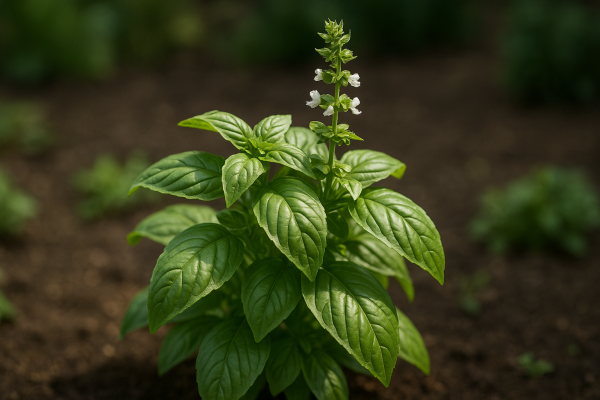
BASIL
#1 Common Name: Sweet Basil
#2 Scientific Name: Ocimum basilicum
#3 Family: Lamiaceae
#4 Origin: Native to tropical Asia, particularly India and Southeast Asia.
#5 Zone Hardiness: USDA Zones 10–11; grown as an annual in cooler climates.
#6 Light Requirements: Full sun; requires at least 6–8 hours of direct sunlight daily.
#7 Water Needs: Moderate; prefers moist, well-drained soil. Water deeply once a week outdoors; indoor plants may require watering every 2–4 days.
#8 Soil Preferences: Thrives in well-drained, fertile soil with a pH between 5.5 and 6.5.
#9 "Ponics" Compatibility:
• Aquaponics: Very compatible
• Aeroponics: Very compatible
• Hydroponics: Very compatible
• Preferred Method: Deep Water Culture (DWC), Nutrient Film Technique (NFT), and media beds using substrates like rockwool, coco coir, or perlite.
#10 Growth Habit: Herbaceous annual in temperate zones; perennial in tropical climates. Upright, bushy growth habit.
#11 Height & Spread: Typically grows 12–36 inches (30–90 cm) tall and 12–24 inches (30–60 cm) wide, depending on variety and conditions.
#12 Time from Germination to Harvest: Germinates in 5–10 days; ready for harvest within 3–4 weeks.
#13 Flowering Time: Blooms from June to frost; flowers are magenta and fragrant.
#14 Edible Parts: Leaves and flowers are edible; commonly used fresh or dried in culinary applications.
#15 Medicinal Uses: Traditionally used to treat digestive issues, colds, and skin conditions. Exhibits anti-inflammatory and antioxidant properties.
#16 Companion Plants: Pairs well with tomatoes, peppers, oregano, parsley, chamomile, and marigolds; helps repel pests and enhance flavor.
#17 Pest & Disease Resistance: Susceptible to downy mildew; resistant varieties like 'Amazel Basil®' and 'Devotion' offer improved resistance.
#18 Harvest Time: Begin harvesting when plants are 6–8 inches tall; harvest in the early morning for best flavor. Store by drying, freezing, or in low-oxygen environments to extend shelf life.
#19 Propagation Methods: Propagated by seeds, cuttings, or division. Seeds germinate in 5–10 days; cuttings root easily in water or soil.
#20 Sustainability Features: Attracts pollinators; its aromatic properties can deter certain pests, contributing to integrated pest management.
#21 Culinary Uses: Essential in Italian and Southeast Asian cuisines; used in pesto, salads, teas, and as a garnish.
#22 Fun Fact: Basil's essential oils vary by region, leading to diverse flavor profiles among cultivars.
Genovese Basil (Ocimum basilicum 'Genovese')
-
Flavor Profile: Sweet, slightly peppery, and aromatic.
-
Culinary Uses: Traditional choice for Italian dishes like pesto, Caprese salad, and tomato-based sauces.
-
Notes: Recognized for its large, tender leaves and is the classic basil variety in Mediterranean cuisine.
Sweet Basil (Ocimum basilicum)
-
Flavor Profile: Mild and sweet with hints of clove.
-
Culinary Uses: Versatile; used in a variety of dishes including salads, pastas, and herbal teas.
-
Notes: Most common basil variety; forms the base for many culinary applications.
Thai Basil (Ocimum basilicum var. thyrsiflora)
-
Flavor Profile: Spicy, licorice-like, and slightly sweet.
-
Culinary Uses: Essential in Southeast Asian cuisines; used in stir-fries, curries, and soups.
-
Notes: Distinctive purple stems and flowers; retains flavor well during cooking.
Lemon Basil (Ocimum × citriodorum)
-
Flavor Profile: Bright citrus aroma with a lemony flavor.
-
Culinary Uses: Enhances seafood dishes, salads, and teas.
-
Notes: Popular in Indonesian and Thai cuisines for its refreshing taste.
Cinnamon Basil (Ocimum basilicum 'Cinnamon')
-
Flavor Profile: Warm, spicy flavor reminiscent of cinnamon.
-
Culinary Uses: Used in teas, baked goods, and Mexican dishes.
-
Notes: Features purple stems and pink flowers; adds a unique twist to sweet and savory recipes.
Purple Basil (Ocimum basilicum 'Purpurascens')
-
Flavor Profile: Mild with a clove-like undertone.
-
Culinary Uses: Adds color and flavor to salads, vinegars, and garnishes.
-
Notes: Known for its striking deep purple leaves; ornamental and edible.
Holy Basil (Ocimum tenuiflorum)
-
Flavor Profile: Peppery and clove-like with a hint of bitterness.
-
Culinary Uses: Used in teas and traditional Indian dishes.
-
Notes: Revered in Ayurvedic medicine; known as Tulsi in India.
Greek Basil (Ocimum basilicum 'Greek')
-
Flavor Profile: Intense and slightly peppery.
-
Culinary Uses: Ideal for garnishing and flavoring Mediterranean dishes.
-
Notes: Compact growth with small leaves; suitable for container gardening.
Spicy Globe Basil (Ocimum basilicum 'Spicy Globe')
-
Flavor Profile: Strong and spicy.
-
Culinary Uses: Perfect for seasoning meats, sauces, and soups.
-
Notes: Forms a small, bushy plant; great for limited spaces.
Dark Opal Basil (Ocimum basilicum 'Dark Opal')
-
Flavor Profile: Similar to sweet basil with a slightly stronger flavor.
-
Culinary Uses: Used in salads, vinegars, and as a garnish.
-
Notes: Developed in the 1950s; notable for its dark purple leaves and ornamental appeal.
Lettuce Leaf Basil (Ocimum basilicum 'Lettuce Leaf')
-
Flavor Profile: Mild and sweet.
-
Culinary Uses: Ideal for salads and wraps due to its large, tender leaves.
-
Notes: Leaves can be as large as lettuce; adds texture and flavor to dishes.
African Blue Basil (Ocimum kilimandscharicum × basilicum)
-
Flavor Profile: Camphor-like with a hint of spice.
-
Culinary Uses: More ornamental; occasionally used in teas and as a garnish.
-
Notes: Sterile hybrid; attracts pollinators and adds visual interest to gardens.
Pesto Perpetuo Basil (Ocimum × citriodorum 'Pesto Perpetuo')
-
Flavor Profile: Mild and sweet.
-
Culinary Uses: Excellent for pesto and fresh dishes.
-
Notes: Variegated leaves with creamy white edges; does not flower, ensuring prolonged leaf production.
Each basil variety offers unique flavors and uses, making them valuable additions to various culinary traditions.
Audio
Video
